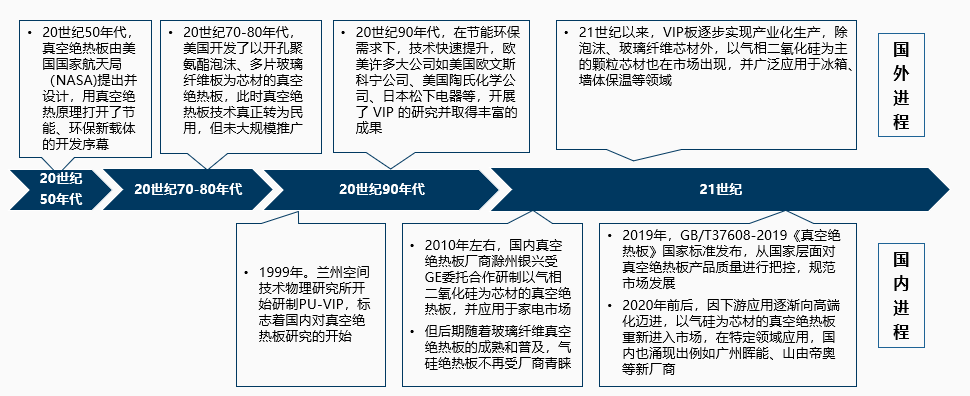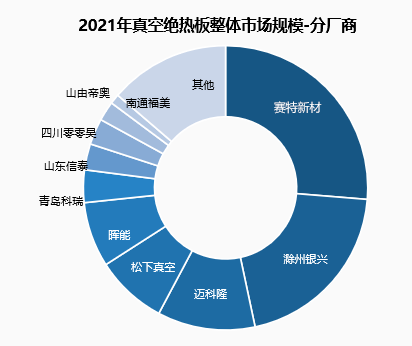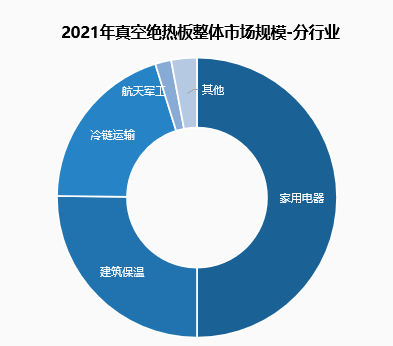

Homepage > CMRC understandings > 【CMRC understanding】With the growth of downstream application demand, vacuum insulation panel manufacturers will accelerate to seize the domestic market.
Hits:3018 Createtime:2023-02-16 16:43:07
Product definition:
Vacuum insulation board is one of the vacuum insulation materials. It is generally composed of three parts: core material, diaphragm and getter. It can avoid heat transfer caused by air convection. It is an excellent insulation product in the field of low temperature and is widely used in household appliances, building insulation and other fields.
History and background:
Since the research and development, the vacuum insulation panel has experienced the transformation from military industry to civilian, from abroad to domestic, and its application field has been continuously extended. At first, in the 1950s, the National Space Administration of the United States proposed and designed vacuum insulation panels, which were used in the field of aerospace and military industry; In the 1990s, with the increasing demand for environmental protection, many large companies in Europe and the United States, such as Owens Corning Company of the United States, Dow Chemical Company of the United States, carried out research on vacuum insulation panels and widely applied them in the civil field. It was not until 1999 that Lanzhou Institute of Space Technology Physics in China started the research on vacuum insulation panels; In 2010, the domestic manufacturer Chuzhou Yinxing, entrusted by the customer GE, cooperated to develop the vacuum insulation board, which was used in the refrigerator and household appliances market; Subsequently, manufacturers such as Guangzhou Huineng and Shanyou Di'ao gradually entered the market.
Since the development of the vacuum insulation board industry, the industry standards and national standards have been gradually completed. For example, QB/T 4682-2014 Vacuum Insulation Board for Household Appliances, GB/T 37608-2019 Vacuum Insulation Board, JG/T 438-2014 Vacuum Insulation Board for Buildings and other documents have been issued, which have improved the industry supervision and also provided a basis for the development of downstream application scenarios of products.

Figure 1: Development history of vacuum insulation board
Industrial chain pattern:
In the upstream of the industrial chain, the core material is the key raw material of vacuum insulation board, and the core material formula is the most technically difficult link in the entire industrial chain, in which the glass fiber core material accounts for 30-40% of the cost and the gas silicon core material accounts for a higher proportion. Therefore, the upstream core material manufacturers have strong bargaining power and voice. The midstream vacuum insulation board manufacturers tend to choose multiple core material suppliers to maintain their own profit level and stable procurement sources. However, with the requirements of scale effect and cost reduction of products, powerful midstream manufacturers have tried to expand their business to upstream core materials. For example, Sete New Materials has introduced core material production lines, Sichuan Linglinghao can make gas silicon core materials, and the status of upstream core material manufacturers has declined.
In the vacuum insulation panel manufacturing industry in the middle reaches of the industrial chain, the domestic market size will be 2.7 billion yuan in 2021 (covering the overall scale of domestic manufacturers' sales abroad and at home), and the products will be mainly exported. In 2021, about 80% of the products will be sold to developed countries with high energy consumption requirements, such as the EU, the United States, Japan and South Korea, but the foreign market will gradually become saturated, and the future growth rate will show a downward trend; Due to the low energy saving standard in the domestic market, traditional thermal insulation materials such as rock wool and polyurethane foam are still used in the market. In the future, with the improvement of the domestic energy consumption standard, vacuum thermal insulation panels will be used in building thermal insulation, high-end household appliances, cold chain transportation and other fields. The proportion of the domestic market has increased and the growth rate is fast. The market development trend will be good in the next 3-5 years, maintaining a high growth rate of about 40%.

Figure 2: Overall market scale of vacuum insulation board manufacturers from 2019 to 2025
In the market competition pattern, there are more than 20 domestic vacuum insulation panel manufacturers, and the top 10 manufacturers are Sete Core, Chuzhou Yinxing, Makron, Panasonic Vacuum, etc. (in addition, there are local small companies that make second-hand materials and have poor product quality). The market concentration is relatively high, and two manufacturers, Sete New Materials and Chuzhou Yinxing, occupy about 50% of the market share. Due to the relatively low technical level and threshold of the midstream industry, new manufacturers have entered the market one after another, and the future market pattern will be decentralized.
In the field of application, vacuum insulation panels are widely used in the field of household appliances, the most common ones are refrigerators, freezers, ovens, water heaters, etc; In the field of construction, internal wall and external wall insulation are mainly used for export to countries with high latitude and cold climate, such as Estonia, which is rarely used in China due to cost, construction difficulty and other factors; Cold chain transportation covers the production, storage, transportation and sales of food and drugs, involving cold stores, refrigerated trucks, refrigerated containers, vending machines, etc. Its subdivided field - medical cold chain, covering the transportation of refrigerated drugs, vaccines, in vitro diagnostic reagents, blood, organs, etc., requires faster thermal insulation technology, and this field has grown rapidly in recent two years due to the epidemic; In addition, aerospace and chemical industries have sporadic applications, such as insulation of pipes, kilns, etc.

Figure 3: Competition Pattern of Manufacturers in the Vacuum Insulation Board Market in 2021

Figure 4: Downstream application pattern of vacuum insulation plate in 2021
In the downstream application link of the industrial chain, the current market is concentrated in foreign customers, mainly in the refrigerator/building field. The penetration rate of vacuum insulation boards in various domestic application fields is extremely low, and the application is not widespread. However, in the context of the dual carbon policy, the energy consumption standards of various industries are gradually improved. For example, the national Cold Storage Design Standard was issued in 2021 to specify the energy consumption requirements of cold storage. In the future, downstream applications will be developed in the domestic market, middle and high-end, refrigerator household appliances/construction/cold chain fields. Vacuum insulation panel manufacturers have good expectations for the future market. In response to the surging demand of the market, they have already hoarded raw material inventory.
In the future, the domestic household appliances market will mainly focus on high-end refrigerators, and only high-end refrigerator product lines priced at more than 8000 yuan/set will consider using vacuum insulation panels. Take Gree Jinghong refrigerator as an example. For the models whose product price is more than 10000 yuan/set, for example, BCD-518WPQGR and BCD-521WIPQG will use vacuum insulation boards to insulate the boxes and doors. In recent two years, affected by the COVID-19, the market has generated high-end demand for refrigerators, such as large capacity and thin door panels. The traditional polyurethane insulation materials can no longer meet the demand. The high-end refrigerator brands on the market will use vacuum insulation panels made of glass fiber core materials, and the market shows a growing trend. The domestic household appliance brands represented by Jinghong refrigerators will gradually increase their use of vacuum insulation boards in the future.
In the future, the domestic cold chain transportation market will mainly focus on high-end food cold chain transportation and medical cold chain transportation, and most customers will also be high-end cold chain customers with high requirements for thermal insulation and high product added value. Take Hema Xiansheng as an example. Its seafood, aquatic products and frozen meat products are sold in high demand for the incubator. In recent years, it has gradually started to use vacuum insulation board incubator, abandoning the traditional polyurethane foam materials. Due to the high discount rate of takeout incubator in use, the usage of Hema Xiansheng will only increase in the future and will maintain a long-term and stable procurement.
Conclusion:
From the perspective of macro environment, although there are various standards for vacuum insulation boards in China, some manufacturers still pass off inferior products as high-quality ones in actual production. The healthy development of the industry must rely on strong market supervision. From the upstream and downstream of the industrial chain, the supply of upstream raw materials is stable; The penetration rate of domestic downstream applications is not high, but there will be explosive growth in domestic, middle and high-end markets, refrigerators and household appliances, construction, cold chain and other fields in the future. Middle stream vacuum insulation panel manufacturers will also shift their focus to the domestic market and speed up their distribution in the domestic market.